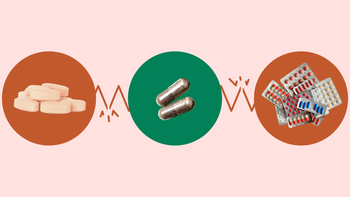
How Much Vitamin D Should I Be Taking a Day? (And How Much Is Too Much?)
Key takeaways:
The recommended daily allowance of vitamin D for adults up to age 70 is 600 international units (IU) a day.
Some people are at higher risk for vitamin D deficiency. These people should have their levels tested. If their levels are low, they may need higher doses of vitamin D.
The best way to get vitamin D is through sunlight, but you can also get it through your diet or vitamin D supplements.
Access savings on related medications
An estimated 41% of Americans don’t get enough vitamin D. This is a problem because vitamin D is important for bone health. Not getting enough vitamin D can lead to consequences like osteoporosis in adults and rickets in children. Researchers are also trying to find out how low vitamin D can lead to other health problems — like heart disease, immune system dysfunction, and cancer. But so far, there’s not enough evidence to know exactly how they’re connected.
All of this might lead you to wonder about your own vitamin D levels. But how do you tell if you have enough vitamin D? And how much is too much vitamin D? Here’s what you need to know.
How much vitamin D per day should I be taking?
Experts have debated this question a lot. But they seem to be settling on a consensus.
In need of menopause symptom relief?
Get Premarin for over 55% less than the average retail price with GoodRx.

The specific amount of vitamin D you need varies by age — and whether or not your levels are low. For people who don’t have low vitamin D levels, the recommended daily allowances are listed below in micrograms (mcg) and international units (IU).
Age | Recommended daily allowance of vitamin D |
Birth-12 months | 10 mcg (400 IU) |
1-13 years | 15 mcg (600 IU) |
14-18 years | 15 mcg (600 IU) |
19-70 years | 15 mcg (600 IU) |
71 years and older | 20 mcg (800 IU) |
According to most medical experts, the recommended dietary allowance (RDA) of vitamin D for adults up to age 70 is 600 IU. But the FDA recommends 20 mcg per day, or 800 IU (1 mcg vitamin D is equal to 40 IU).
The best way to get your daily vitamin D is through exposure to sunlight. That’s because your skin makes vitamin D when it absorbs ultraviolet (UV) light. All you need is 5 to 30 minutes of sunlight exposure every day to make enough vitamin D. But remember not to spend too much time in the sun. Too much sun exposure increases your risk of skin cancer.
How much vitamin D per day for a woman?
There is no difference in the amount of recommended vitamin D for men versus women.
Researchers have looked into sex differences in vitamin D levels. The results are inconsistent. Some studies show low vitamin D is more common in women. Others show it’s more common in men. It’s also possible that women are more likely than men to experience complications from low vitamin D levels — especially when it comes to bone and muscle health. But all this research is in the early stages, and it’s too soon to know.
All that being said, this does not change the recommended amounts of vitamin D. The RDA for women below the age of 70 is 600 IU. This includes anyone who is pregnant or lactating.
How do you know if you’re vitamin D deficient?
First, it’s important to know that there’s no reason to screen for vitamin D deficiency. In other words, most adults don’t need to be tested unless they are at high risk for having low vitamin D.
Read more like this
Explore these related articles, suggested for readers like you.
If you’re at risk, a simple blood test with your primary care provider will tell you if you’re vitamin D deficient. The test measures your “25-hydroxyvitamin D” levels.
To further complicate things, expert groups don’t agree on what level is considered deficient. But most agree that a vitamin D level less than 20 ng/mL is considered deficient. And severe deficiency is defined as a vitamin D level of less than 12 ng/mL.
Vitamin D deficiency causes
Some people are more likely than others to have vitamin D deficiency. You might be at risk for vitamin D deficiency if you:
Live in a sun-deficient area
Have darker skin tone
Are older (the ability to make vitamin D decreases with age)
Rarely expose your skin to sunlight
Have increased body weight
Take medications that affect how quickly you process vitamin D (such as phenytoin or orlistat)
Have a condition that impairs vitamin D absorption from your gut (like inflammatory bowel disease, celiac disease, or prior gastric bypass surgery)
There’s an increased number of cases of vitamin D deficiency in adults today. This is attributed to changes in diets, an increased use of sun protection, and higher rates of obesity.
The risks of vitamin D deficiency
Vitamin D is a hormone we all need to absorb calcium and phosphorus from our diets. These two minerals are critical for bone health. That’s why young children who don’t get enough vitamin D can develop rickets. And older adults can develop osteoporosis and fractures.
Also, without vitamin D you may experience muscle weakness. In theory, this can increase your risk of falls, although the evidence is mixed.
Vitamin D deficiency may increase your risk of heart disease and certain cancers, too. However, there is limited scientific data to suggest that supplementation beyond the daily recommended amounts is required or helpful.
What happens if I take too much vitamin D?
There doesn’t appear to be any toxicity associated with the recommended levels of vitamin D supplementation. But it may be a problem if your blood levels of 25-hydroxyvitamin D go above 50 ng/mL, although this is rare. Ideally, you want to maintain your vitamin D levels between 30 ng/mL and 50 ng/mL.
Vitamin D increases how much calcium is absorbed by the gut. So one reason too much vitamin D is dangerous is because it can cause high calcium levels. This can lead to:
Nausea and vomiting
Muscle weakness
Kidney stones
Confusion
Dehydration
Very high levels of vitamin D can cause kidney failure, irregular heart rhythms, and even death. Most often, vitamin D toxicity is due to supplements, not sunshine exposure.
What vitamin D supplements do I need to take to get my 25-hydroxyvitamin D levels above 30 ng/mL?
Vitamin D supplements are available as vitamin D2 or vitamin D3 — both of which can be used if you don’t get enough vitamin D already. Studies suggest that vitamin D3 increases vitamin D levels faster than vitamin D2 does, especially at higher doses. But both types of vitamin D will still increase your levels.
How much vitamin D3 should I take per day?
Vitamin D3 is available in the following dosage amounts:
400 IU
800 IU
1,000 IU
2,000 IU
5,000 IU
10,000 IU
50,000 IU (available by prescription only)
If your blood levels are really low, you may need high doses under the direction of a healthcare professional. In people with vitamin D levels less than 20 ng/mL, they often start with 50,000 IU of vitamin D3, once a week for 6 to 8 weeks. After that, a dose of 800 IU to 2,000 IU per day can help maintain vitamin D levels above 30 ng/mL.
After taking vitamin D supplements for 3 to 4 months, have your levels rechecked to ensure you’re on the right track. As always, talk to your primary care provider or pharmacist if you have any questions.
How else can I get more vitamin D?
With so much talk around supplements, it’s easy to forget that you can also get vitamin D through your diet. Fatty fish such as salmon are a good source of vitamin D. But not many foods have it. Vitamin D-fortified dairy products can help. And red meat, egg yolks, and cheese all have a small amount of vitamin D.
That being said, there are some foods that contain more vitamin D than others. Cod liver oil is among the best sources of vitamin D. One tablespoon provides 34 mcg or 1,360 IU of vitamin D.
Mushrooms also contain vitamin D. There are some mushrooms on the market that have been specially treated with UV light to increase their vitamin D content. The U.S. Department of Agriculture (USDA) also recently approved UV-treated mushroom powder as a food additive to help combat vitamin D deficiencies.
Foods high in vitamin D
There are several other foods to keep in mind if you’re looking to increase your vitamin D intake. These include:
Cod liver oil
Trout
Salmon
Tuna
Red meat
Egg yolk
Fortified breakfast cereals
Fortified dairy products
Mushrooms
Chicken breast
Sardines
The bottom line
Vitamin D is an important nutrient that helps maintain healthy bones and muscles. The best way to get vitamin D is through sunlight, but you can also get it through your diet. If you think you’re deficient in vitamin D, you can take a blood test through your primary care provider to find out. Supplements can increase your vitamin D levels if you aren’t getting enough.
Why trust our experts?


References
Amrein, K., et al. (2020). Vitamin D deficiency 2.0: An update on the current status worldwide. European Journal of Clinical Nutrition.
LeFevre, M. L. (2015). Screening for vitamin D deficiency in adults: U.S. Preventive Services Task Force recommendation statement. Annals of Internal Medicine.
Office of Dietary Supplements. (2022). Vitamin D: Fact sheet for consumers. National Institutes of Health.
Office of Dietary Supplements. (2023). Vitamin D: Fact sheet for health professionals. National Institutes of Health.
Parva, N. R., et al. (2018). Prevalence of vitamin D deficiency and associated risk factors in the US population (2011-2012). Cureus.
U.S. Food and Drug Administration. (2023). Sec. 172.382: Vitamin D2 mushroom powder. Code of Federal Regulations Title 21.
U.S. Food and Drug Administration. (2024). Daily value on the new nutrition and supplement facts labels.
Wierzbicka, A., et al. (2022). Sex differences in vitamin D metabolism, serum levels and action. British Journal of Nutrition.




























